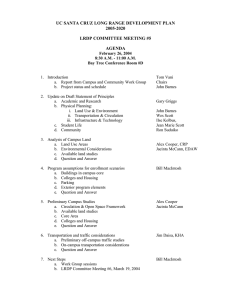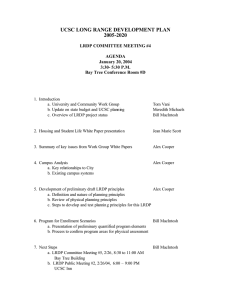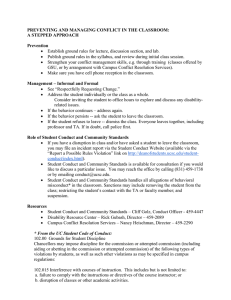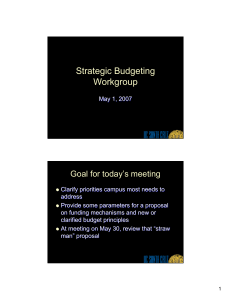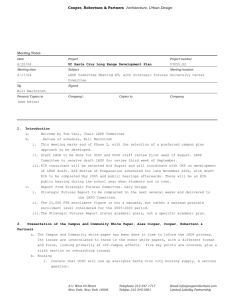Cooper, Robertson & Partners
advertisement
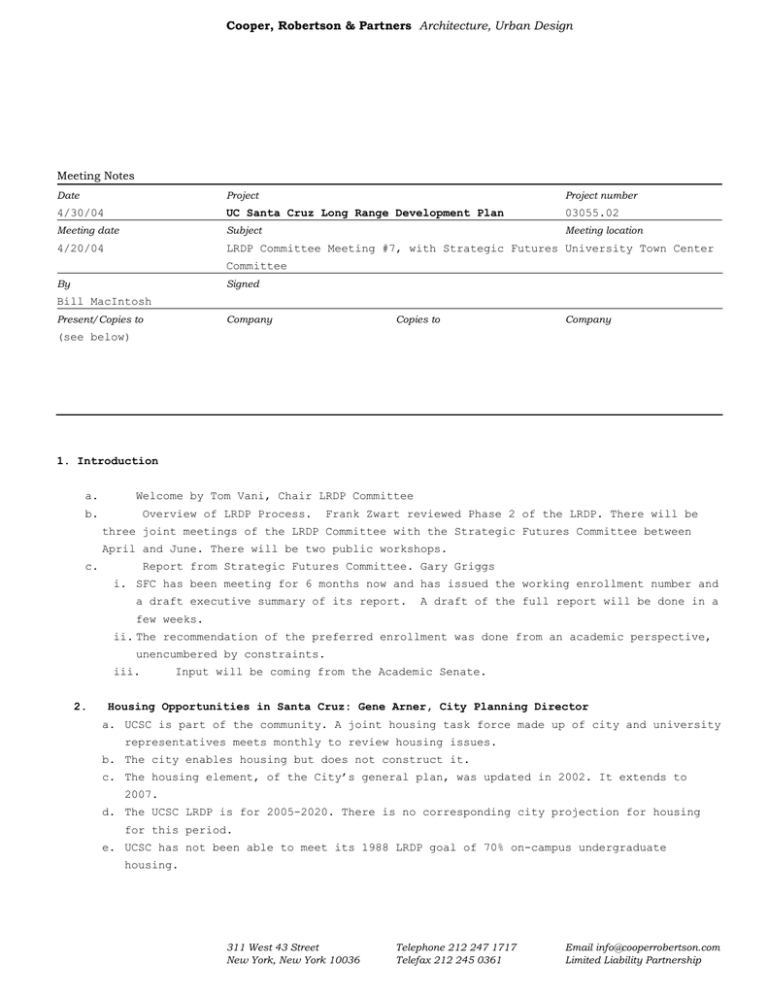
Cooper, Robertson & Partners Architecture, Urban Design Meeting Notes Date Project Project number 4/30/04 UC Santa Cruz Long Range Development Plan 03055.02 Meeting date Subject Meeting location 4/20/04 LRDP Committee Meeting #7, with Strategic Futures University Town Center Committee By Signed Bill MacIntosh Present/Copies to Company Copies to Company (see below) 1. Introduction a. Welcome by Tom Vani, Chair LRDP Committee b. Overview of LRDP Process. Frank Zwart reviewed Phase 2 of the LRDP. There will be three joint meetings of the LRDP Committee with the Strategic Futures Committee between April and June. There will be two public workshops. c. Report from Strategic Futures Committee. Gary Griggs i. SFC has been meeting for 6 months now and has issued the working enrollment number and a draft executive summary of its report. A draft of the full report will be done in a few weeks. ii. The recommendation of the preferred enrollment was done from an academic perspective, unencumbered by constraints. iii. 2. Input will be coming from the Academic Senate. Housing Opportunities in Santa Cruz: Gene Arner, City Planning Director a. UCSC is part of the community. A joint housing task force made up of city and university representatives meets monthly to review housing issues. b. The city enables housing but does not construct it. c. The housing element, of the City’s general plan, was updated in 2002. It extends to 2007. d. The UCSC LRDP is for 2005-2020. There is no corresponding city projection for housing for this period. e. UCSC has not been able to meet its 1988 LRDP goal of 70% on-campus undergraduate housing. 311 West 43 Street New York, New York 10036 Telephone 212 247 1717 Telefax 212 245 0361 Email info@cooperrobertson.com Limited Liability Partnership Cooper, Robertson & Partners Architecture, Urban Design Meeting Notes f. Gene Arner predicts UCSC may need approximately 1,500 additional housing units over the next 15 years for 21,000 students. Historically Santa Cruz has averaged 100 new units of housing a year, with a high of 900 units one year. This is not to suggest that UCSC would take all additional SC housing stock, but to identify the challenge. g. Santa Cruz wants to maintain diversity and balance, and not become a university town. h. Land does not exist for many new units of single family housing. Opportunities to find appropriate housing for students exist along transit corridors (Mission Street) and in parts of Downtown. i. The city housing element identifies 2,850 units that could be located in the city by 2007 for satisfying AMBAG requirements. j. Private development is preferable so properties stay on the tax role. 3. City perspective on UCSC Long range Development Plan, Dick Wilson, City Manager a. Dick Wilson, the city manager, was asked by Emily Reilly to present insights on the city’s perspective on behalf of the Campus and Community work group. b. Wilson noted that he likes the university and that it has 99% beneficial impacts. City government has a very different perspective, however. c. Local governments exist to deal with negatives. He noted the unique tax structure of cities in California. It is not not always logical but is what it is. d. Santa Cruz had been averse to development until the 1990’s when it realized the need for some more development at the low end of the continuum income. 800 units of housing were recently approved. This would never have happened earlier. e. Water supply is a major issue for the city. It has no reserve supply and cannot cope with a drought. Businesses would have to close during a drought. Santa Cruz has proposed a desalination plant to handle drought conditions. There is widespread recognition that something has to be done. f. The city has not anticipated a campus with 21,000 students. There is a fear UCSC will take the lion’s share of water and housing. g. Proportionate impact is different here than at other U.C. campuses given the relative small size of Santa Cruz compared to other communities such as Berkeley. h. The city and the university are really dependent on each other. 4. Update from LRDP Work Groups i. Land Use and Environment, Frank Zwart. The group has been having work sessions to advance planning studies. ii. Circulation and Transportation work group, Wes Scott. Advisory committees on transportation have been meeting with the consultants and providing input, addressing on and off-campus transportation, circulation and parking issues. The work has been successful. LRDP Committee Meeting #7 CRP No. 03055.00 Page 2 of 8 Cooper, Robertson & Partners Architecture, Urban Design Meeting Notes iii. Infrastructure. The work group met with Arup and is developing projected utility usage for both “straight lined” and mitigated scenarios. Much emphasis is being put on studying water consumption and possible mitigation strategies in light of concerns over possible future drought conditions. Utilities and infrastructure will be reviewed at the next LRDP/SFC meeting. iv. Housing and Student Life, Jean Marie Scott. The work group has been working with CRP to develop the housing program and principles. v. Campus and Community work group. Issues discussed noted above by Gene Arner and Dick Wilson. 5. Report from Strategic Futures Committee, Gary Griggs, Chair a. SFC has met for 6 months now and has provided a working enrollment number for the LRDP of 21,000 FTE and an executive summary. b. A draft report will be done in a couple of weeks. c. Input will be coming from the academic senate. 6. Program Update and Site Design Studies, Cooper, Robertson & Partners a. Bill MacIntosh gave an overview of the updated program for 21,000 FTE. b. Additional program area for space, other than housing, is approximately 100% of existing and approved space (in essence a doubling of space). c. On-campus housing goals: Undergraduates: 50% (with alternative land study for 70%); graduate students: 25%; faculty: 25%; staff: 2%. d. UCSC staff hiring has been highest from city residents. UCSC to show hiring statistics by 3 county location. e. Alex Cooper presented option studies for land use. The studies are very preliminary and in-process. Some follow the 1988 LRDP land use boundaries. Others do not. One may drop out. Others may emerge. f. Option A is the most predictable and comfortable. It creates a north loop road for new colleges and housing to the north and adds density to the existing core. There is minimal in-fill housing in existing developed areas. g. Option B also adds a loop road in the north campus and expands the core land area inside this road. Two new colleges and a graduate college are located outside the loop road. 1988 Land Use boundaries are changed to use a portion of the natural reserve for the expanded core. There is moderate in-fill housing. h. Option C extends Heller Drive to Empire Grade and develops new colleges and apartments off this road. 1988 land use boundaries are unchanged. There is moderate in-fill housing. i. Option D expands the campus East-West by locating a graduate college in the Porter Meadow and 2 new colleges in the OPERS east field. Replacement fields plus expansion would be located in the East Meadow. All new apartments are done as infill with no new loop road or development in the north campus. 1988 LRDP land use boundaries are LRDP Committee Meeting #7 CRP No. 03055.00 Page 3 of 8 Cooper, Robertson & Partners Architecture, Urban Design Meeting Notes changed (Porter meadow is protected landscape and OPERS and housing boundaries would be changed. j. Faculty staff housing is shown west of Empire Grade in campus resource land (former inclusion area B’). This is outside the city boundary. k. A study for a 5,000-seat recreation and event center at the north west end of the east remote lot was reviewed. 7. Landscape and Open Space Studies, Jacinta McCann, EDAW a. A study of surrounding parklands and trails shows how the UCSC campus links these areas together. Maintaining trail continuity will be part of the planning process. b. Recommended habitat continuity zones were proposed. Most options preserve these. Housing in the north campus will be studied to maintain this continuity as much as possible. Option B can be modified to allow these to be more open. c. An elevation analysis was presented for each option to assess grade changes relative to the existing development pattern. Music to engineering currently has a differential of 190 vertical feet. In options A there it is 140 vertical feet between quarry plaza and new colleges 11 and 12 and 190 vertical feet from there to the northern most apartments. In Option B new core areas in the north campus are 20 feet above engineering and north apartments are 140 feet above new colleges 11 and 12. d. Option D has no vertical climb since new development is done as infill without developing the north campus. e. Studies for relocating the OPERS fields to the east meadow for Option D were reviewed. 8. Traffic Analysis, Jim Daisa, Kimley-Horn Associates a. Jim Daisa presented an update of off-campus traffic analysis and on-campus considerations. b. For off campus traffic, Jim reviewed the mitigation process. Investigating measures for Travel Demand Reduction is the first step. After this, if additional mitigation is required engineering measures can be identified. c. KHA reviewed potential TDR measures with TAC/TOC. The committee prioritized possible measures. High priorities include a. maintaining and improving the current mode share of transportation to campus through enhanced TDM programs b. Increasing retail / services on campus and c. implementing transit preemption/queue jumping lanes for transit on campus and at selected off campus locations to improve service. d. Medium-high priorities include a. campus provide direct express east side bus service to b. provide east side and/or south county remote park and ride facility c. modify class and staff scheduling to reduce travel peak demand and d. expand van pool fleet. e. Medium and low priorities were also reviewed. Locations off-campus for possible street and intersection improvements were listed. LRDP Committee Meeting #7 CRP No. 03055.00 Page 4 of 8 Cooper, Robertson & Partners Architecture, Urban Design Meeting Notes f. Some of the on-campus pedestrian and bicycle improvements noted included new pedestrian bridges, a bike management plan for the natural reserve, a pedestrian spine thorugh the campus, bike lanes on campus roads, pedestrian separation on McLaughlin Drive, and closing McLaughlin Drive to traffic. g. Possible on-campus parking management steps include building a super collector lot and transit hub at the east remote lot, implementing “congestion” pricing, establishing a ceiling on parking, providing off-campus car storage for on-campus residents, and increased use of zoned parking permits. h. The four land use options were reviewed. Option C, extending Heller to Empire Grade, would be difficult to serve with transit since facilities are widely separated. Option D, East West expansion, essentially maintains the existing transit system and makes it difficult to close McLaughlin to traffic since there is no north loop road. i. Jim concluded with an overview of on-campus performance measures for vehicle circulation, the bicycle system, the pedestrian system and the transit system. 9. Breakout Session Prior to breaking into 6 discussion tables, the LRDP and SF committee members were given a questionnaire on various issues and asked to select the approach that you think is most appropriate for developing the LRDP . The responses were tabulated and reported at the end of the session. a. Development and conservation of the campus core 18 Maximize viable in-fill projects in the core to minimize disturbance to undeveloped campus natural areas, to facilitate program adjacencies and to promote a walkable campus. 0 Pursue a balance of selected in-fill projects and core expansion to maintain the natural character of the core as much as possible and establish new potential core areas for future growth. 20 Limit infill development of the core as much as possible, expanding the core to the north. b. Location of new on-campus organized research space (ORU/ORA) 23 Locate some new organized research space near existing respective academic departments, 15 with the balance as interdisciplinary research facilities within the core. Locate some organized research space in the north campus as an interdisciplinary research area, with the balance near existing respective academic departments. LRDP Committee Meeting #7 CRP No. 03055.00 Page 5 of 8 Cooper, Robertson & Partners Architecture, Urban Design Meeting Notes 0 Locate all new organized research space in the north campus in a separate interdisciplinary research area c. Location of new colleges and on-campus student housing 0 Avoid in-fill housing. Develop north campus for new colleges and housing to minimize disturbance of 19 the setting of the existing colleges. Pursue some in-fill housing that is economically viable and sensitive to the natural setting with the balance of new colleges and housing in the north campus. 19 Maximize in-fill development that is economically viable, to minimize disturbance of the north campus natural area and promote a more walkable campus d. Transportation and Parking 31 Maximize opportunities for a pedestrian-centered campus core by reducing car access and parking in the coreand facilitating shuttle service. Provide collector lots/garages at the perimeter of the core 6 Retain car access and parking throughout existing the core for convenience. 1 Blend of above approaches Committee members were asked to list and rank what you consider to be the three most important criteria which the 2005-2020 Long Range Development Plan should meet to be successful. The most listed criteria were: - Preserve natural beauty of campus (11 responses) - Meet academic goals (7) - Improve point-to-point travel time on-campus (7) - Maintain undergraduate communities and spaces (5) - Sustainability, balance of in-fill with innovative new environment (5) - Thoughtful, creative process for campus , working with the community (5) - Future flexibility. Following the breakout session, the table leaders summarized the discussions. a. Alex Cooper - Importance of funding strategies - Virtues of north loop road - Option D without loop road does not appear to provide flexibility for future growth - Option C not desirable b. Frank Zwart - Option C should not be developed. LRDP Committee Meeting #7 CRP No. 03055.00 Page 6 of 8 Cooper, Robertson & Partners Architecture, Urban Design Meeting Notes - No overkill on in-fill. Must be judicious. Need spaces between buildings to remain natural - Use “tartan grid” as model for assessing options - Location of corp yard in Option B positive, even with bridge cost. OK to split different corp yard functions to put in appropriate locations - A parking structure might eventually go in the lower quarry - Employee housing in Inclusion Area B’: in coastal zone. Difficult campus access. Tax revenue to city - Need to look at other locations for employee housing c. Bill MacIntosh - Support for more study of Options A, B, D. Drop Option C. - Perception that Option D is least expensive, most walkable - Concern for maintaining character of core. Keep as many trees in the core as possible. - Need to untangle cars and pedestrians at Quarry Plaza - Proposal for setbacks from roads. Some recent development too close. - Core expansion in Option B could be used for professional schools and free-standing research. Difficult for this to be interdisciplinary research. - Support for east remote lot parking structure, transit hub, connection to Coolidge d. Jonie Fu - Keep natural character of core as much as possible while adding density - Eliminate/ reduce private cars in core - Meyer Drive extension needs to happen - Grad College at north of Porter Meadow supported - Relocation of fields in Option D a concern. Visibility of lighting. - “we want it all, and we want the best” e. John Barnes - Support for relocation of corp yard and bridge to Empire Grade - Option D considered too congested. Likely negative alumni reaction on view impacts - Elusive quality of existing campus. Arrival sequence and views of the meadows area part of this - Support for grad college at north of Porter Meadow - Loop road in Options A and B invest in future expansion. This should be acknowledged, - Core density can equal convenience, especially for class changes. LRDP Committee Meeting #7 CRP No. 03055.00 Page 7 of 8 Cooper, Robertson & Partners Architecture, Urban Design Meeting Notes - Can Social Sciences expand northeast; Engineering/Science expand northwest? - Location of employee housing needs more study f. Jacinta McCann - Options A, B, D to be pursued; Option C dropped. - Feasibility and economic considerations important. - Advocates for north loop road to provide needed future flexibility - Support for grad college at north of Porter Meadow - Little support for new colleges at OPERS fields - Is this much area needed for fields? 10. Next steps a. Public Workshop #3, April 21 [6:00- 9:00 PM, UCSC Inn, Sierra Room] b. LRDP Committee Meeting #8, Tuesday. May 18 Joint meeting with SFC. [5:30- 9:30 PM, UCSC Inn and Conference Center, LRDP Committee Meeting #7 CRP No. 03055.00 Page 8 of 8 Cooper, Robertson & Partners Architecture, Urban Design Meeting Notes Committee members present: Members Not Present Tom Vani, Chair Michael Bade Gene Arner Jim Dunne Tamara Belknap Greg Gilbert Mike Bolte Gary Glatzmaier Donna Blitzer Bill Hyder Harriet Deck Patrick LeCuyer Peggy Delaney Robert Miller Pamela Edwards David Rinehart Amy Everitt Leslie Sunell Maggie Fusari Christina Valentino Wlad Godrich Carl Walsh Gary Griggs Jack Zimmermann Gail Heit Francisco Hernandez Staff present: Karen Holl John Barnes Liz Irwin Teresa Buika Steve Kang Dean Fitch Ilse Kolbus Galen Jarvinen Larry Merkley Ken Thomas Meredith Michaels Fran Owens Consultants present: Emily Reilly Alex Cooper Jean Marie Scott Bill MacIntosh Wes Scott Jonie Fu James Sheldon Jacinta McCann Ron Suduiko Megan Walker Matt Waxman Jim Daisa Mardi Wourmhoudt Frank Zwart LRDP Committee Meeting #7 CRP No. 03055.00 Page 9 of 8
